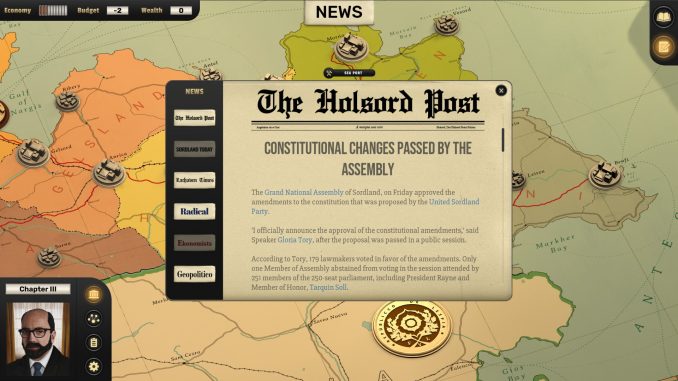
General Tips on Economic Planning
Investment Tips
You will experience more economic gain if you concentrate your investments. For example if you invest in Bergia the Sarna agricultural zone will be more effective. Otherwise, you can spread out your projects so you recover every region. This way you will spend your budget more inefficiently but end up with a stronger economy in the end. In general, it is easier to concentrate your investments for higher economic gain compared to government budget spent.
Indirect Factors which impact the Economy:
There are some factors which have an impact on the economy but it might not be clear. For example, cutting the military’s personnel decreases economic development. Increasing its size decreases unemployment. Being friendly with the Oligarchs significantly boosts the economy. Picking Underhall for construction makes them happy and so does the railway.
Economy types and an example of a recovery
Planned Economy
With a planned economy you can trade with Wehlen, Valgsland and Agnolia. It relies on nationalization. A planed economy is better for war and can help increase living standards due to not privatizing education or health.
An example of a recovered planned economy is:
First infrastructure project – highway (-1)
Invest in Lorren (-1)
Raise taxes depending on budget
Trade with Agnolia (-1)
Trade with Wehlen (+2)
Invest in Morna Port (-2)
Nationalize companies (-2)
Trade with Valgsland (+2)
Market Economy
With a market economy you can trade with Wehlen, Lespia and Agnolia. It relies on limited government intervention and privatization. A market economy can decrees living standards if health and education are privatized without extra budget.
An example of a recovered market economy is:
First infrastructure project – railway (-1)
Lower taxes on small, medium and big businesses (-3)
Privatize education (+1)
Trade with Agnolia (0)
Invest in Benfi airport (-2)
Privatize companies (+3)
Trade with Lespia (0)
Time to make Symon proud.
Turn I
Mega Infrastructure project ( -2 – -1 Budget)
- Highway – Agnland, Can be improved by investing in Agnland and trading with Agnolia
- Railway – Better for economy on its own, Happier oligarchs, Happy Gus
Companies
- SSC – Planned economy, Requires more funds or delays project
- Underhall – Happy oligarchs, No delay, Problems with Workers’ rights bill, -1 Government Budget, Market economy
- Taurus – Problems with Workers’ rights bill, Can be exploited by vetoing the WRB and passing it later, Market economy
Turn II
Economic Relief Act ( -1 Budget)
- Stimulus checks – Less Unrest, Higher Opinion, Malenyevist
- Business bailouts – Happy Oligarchs, Lower Opinion, Generally better for the economy, Capitalist, Happy Gus
- Reject plans – -1 Economic development
Turn III
Budget ( -4 – +4 Budget)
Health ( -1 – +1 Budget)
- Fund – Relieved welfare system, Improved living standards, Epidemic tackled, Get money back later
- Maintain – No improvement, Problems in pandemic, Overburdened welfare system
- Defund – Decrees in quality and access, Lower living standards, Problems in pandemic, Overburdened welfare system
Education ( -1 – +1 Budget)
- Fund – Relieved welfare system, Improved access, Education reform, Less Sollism
- Maintain – No improvement, Failed education reform, Overburdened welfare system
- Defund – Brain drain, Failed education reform, Overburdened welfare system
Law & Enforcement ( -1 – +1 Budget)
- Fund – ACP or SSP, Less unrest, Tackled crime
- Maintain – No change
- Defund – Higher unrest
Military ( -1 – +1 Budget)
- Fund – Stronger in war, Reduced coup chance, Cheaper military industry
- Maintain – Chance of coup
- Defund – Weak in war, High chance of coup
Turn IV
Worker’s rights act ( -1 Budget)
- Sign – Less unrest, Higher opinion, Worse relations with Oligarchs, Malenyevist
- Veto – Lower opinion, Happier Oligarchs, Capitalist
Investment ( -1 Budget)
- Bergia – Increased Blud opinion, Increased regular Opinion, 1 Economic development, Improved local economy, Improved Sarna agricultural zone
- Lorren – Higher opinion, 1 Economic development, Improved local economy, Improved Morna port
- Agnlnad – Increased opinion, 1 Economic development, Improved local economy, Improved highway
- Don’t invest – No effect
Taxes ( -3 – +3 Budget)
Raise (+1 – +3)
- On corporations – Lower Oligarch opinion, +2 budget, significantly lower ED, Malenyevist
- On small and medium businesses – +1 budget, lower ED, lower living standards
Lower (-1 – -3)
- On corporations – Happier Oligarchs, -2 budget, significantly increased ED, Capitalist
- On small and medium businesses – -1 budget, increased ED, slightly higher living standards, Capitalist
Education Privatization ( 0 – +1 Budget)
- Privatize – +1 Government budget, +1 Improvement, Capitalist, Decreased quality, Decreased living standards if you haven’t invested in education, Lower Conservative opinion, market economy
- Don’t – Malenyevist, planned economy
Turn V
Black Tuesday / Trade War
- Black Tuesday – Only happens if the budget deficit is larger or equivalent to 4
- Trade War – Only happens if the budget surplus is larger or equivalent to 4
Note: Keep budget at least at -3 and at most +3 to avoid economic disaster.
Superpowers Offering Financial Aid ( +1 Budget)
- Arcasia – Better relations with Arcasia, +1 Government budget, Increased coup chance, Can’t trade with Valgsland
- United Contana – Better relations with United Contana, +1 Government budget, Businesses worrying, Increased coup chance, Can’t trade with Lespia
Trade Deal ( -1 – +2 Budget)
- Agnolia
- Expensive steel – Improvements in Agnland, -1 Government budget
- Cheaper steel – Improvements in Agnland, Can’t trade with Valgsland
- Wehlen
- Take part in operation – +2 Government budget, lower Blud opinion, International problems, Alliance if no unrest in Bergia, Bad trade deal with Lespia
- Close borders – +2 Government budget, Somewhat lower Blud opinion, Bad trade deal with Lespia
- If not trading with either – Failed trade negotiations
Turn VI
Economic Investment Project ( -2 Budget)
- Benfi International Airport – Improved infrastructure, Useful when trading with Lespia
- Morna Port – Improved infrastructure, Useful when trading with Valgsland, Can be improved by investing in Lorren
- Conriat Industrial Zone – Raises production, Can (?) be improved by railway
- Sarna Agricultural Zone – Raises production, Can be improved by investing in Bergia
Companies:- Taurus
- Passed workers’ rights – Market economy, -1 Government Budget
- Vetoed workers’ rights – Market economy, Free
- Underhall – Market economy, -1 Government budget, Happier oligarchs
- SSC
- Planned economy – Planned economy, Free
- Market economy – -1 Government budget
- Taurus
Health Privatization ( 0 – +1 Budget)
- Privatize – +1 Government budget, +1 Improvement, Capitalist, Decreased quality, Significantly decreased living standards if you haven’t invested in health, Lower Conservative opinion, market economy
- Don’t – Malenyevist, planned economy
Turn VII
Nationalize/Privatize ( -2, +3 Budget)
- Nationalize – Worries business, Happier Old Guard and Conservatives Malenyevist, Helps with planned economy, Planned economy helps with war ( -2 Government budget)
- HOS – Fully nationalize – -1 budget (If not full, Koronti will smear your reputation in the media)
- Bergia Steel – Fully natinalize – -1 budget, Tusk hates you (Do this if allied with Koronti and/or not friendly with Tusk)
- Status Quo – No change
- Privatize – Worries conservatives, Capitalist
- Minority share – +2 Government budget, Decreases conservative support, Content Oligarchs
- Majority share – +3 Government budget, Lowers conservative support, Happy Oligarchs
- Full – +3 Government budget, Breaks conservative support, Happier Oligarchs
Hope you enjoy the Guide about Suzerain – A Guide to Government Budget management and the Economy, if you think we should add extra information or forget something, please let us know via comment below, and we will do our best to fix or update as soon as possible!
- All Suzerain Posts List


this guide is not accurate for current game patch. taxing has been changed, therefore choices are harsher and more likely to lead to negative government budgets by turn 5, which will tank your economy.
Agnolia
Expensive steel – Improvements in Agnland, -1 Government budget
Cheaper steel – Improvements in Agnland, Can’t trade with Valgsland
What does this mean? I can get a deal even if I don’t accept their demand for more expensive steel? But then I can’t trade with Valgsland? Why?
to get cheaper steel you have to recognize heljiland as Agnolian, doing so pisses of Valgsland because they seek to take back the territory after Valgish citizens are killed